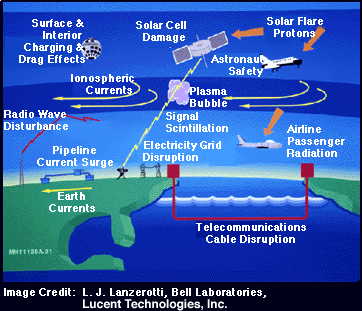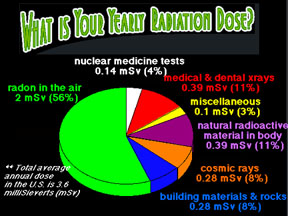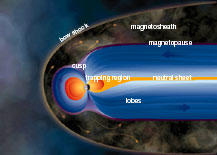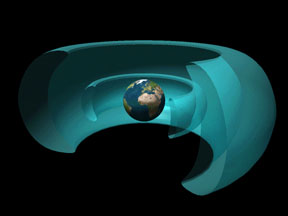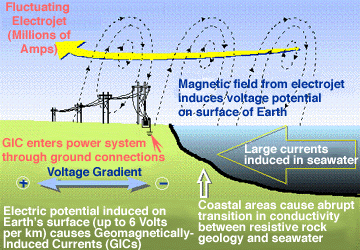Click on image for full size
Image courtesy L. J. Lanzerotti, Bell Laboratories, Lucent Technologies, Inc.
How does Space Weather affect Earth and Human Society?
Although space weather forecasts are not normally featured on the evening news, space weather does impact life on Earth in many ways. Our modern, technologically complex systems - including communications, transportation, and electrical power systems - can be disrupted and damaged by space weather storms. Exposure to radiation can threaten astronauts and commercial air travelers alike, and has affected the evolution of life on Earth. Space weather probably alters the weather and climate on our planet, though we don't yet have a precise understanding of those influences.
Earth's magnetic field is our radiation shield. Our planet's magnetosphere keeps most of space weather's effects where they belong; safely out in space! Some radiation does, however, reach orbiting satellites and astronauts, people in aircraft, and sometimes even the ground. Energetic particles can damage satellites and shorten their lifespans. Radiation poses a hazard to astronauts and to the passengers and crew onboard commercial airline flights at high latitudes near Earth's poles. Mutation rates, partially driven by exposure to radiation, have influenced the evolution of all life on Earth.
Many aspects of our modern technology can be disrupted by space weather storms. Changes in the ionosphere alter long-distance radio signals and Global Position Systems (GPS). Strong magnetic fields can diminish the accuracy of compasses, disrupt magnetic prospecting, and even cause homing pigeons to go astray. The same magnetic fields can induce electrical currents at ground level that can destroy electrical power distribution grids, interrupt telegraphs, and even increase corrosion in pipelines.
Heat and light from the Sun play a dominant role in Earth's weather. It seems likely that variations in the Sun should cause changes in Earth's weather and climate. They probably do, but scientists aren't yet sure exactly how those connections work. Atypical periods in the Sun's 11-year sunspot cycle seem to correlate with severe cold snaps, though the correlations are imperfect. Large variations in the Sun's output of ultraviolet (UV) radiation over the course of the solar cycle influences the rate of production and destruction of stratospheric ozone. Solar and space weather variations may influence rates of cloud formation and the freezing of airborne water droplets. The Sun's multifaceted influence on Earthly weather is the subject of much continuing research.


